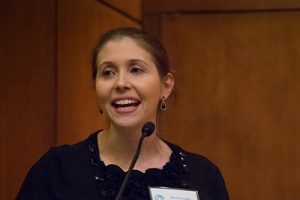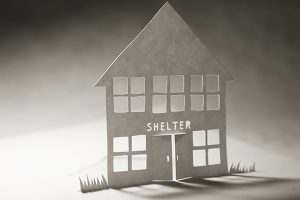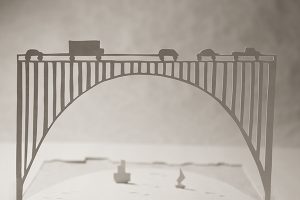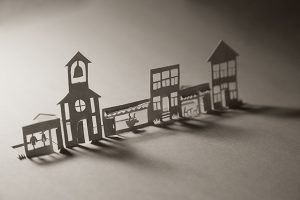The UNC School of Medicine has long valued the role of community service in medical education and emphasized focus on care for underserved populations. Second-year medical student Blaire Hanvey, winner of this year’s June C. Allcott Fellowship in Medicine and the Zollicoffer-Cross Community Health Fellowship, shares how community service enhances medical education.

Second-year medical student Blaire Hanvey has embraced education globally and locally – as a volunteer teacher in Ghana and later, as a classroom teacher in Alamance County. She has also designed academic interventions for struggling students and spent summers as a pediatric home health aide.
In her first year as a UNC medical student, Blaire’s community service earned the June C. Allcott Fellowship in Medicine and the Zollicoffer-Cross Community Health Fellowship. This year, she will help launch Beyond Clinic Walls for Kids, a new SHAC program that serves local families who have children with complex medical needs. Below Blaire offers ways community service enhances medical education for students.
 Renews your vision
Renews your vision
Medical students are driven. We make checklists, to-do lists, and ten-year plans. We fixate on the future and methodically plot every big step in our med school careers. Often, we ask, “What’s my purpose? Where am I headed? What’s supposed to be my role in medicine?” In looking forward, we often fail to look back. We forget to consult the passions and interests that initially launched us to medical school.
Community service offers medical students a chance to renew their vision by providing opportunities to pursue old interests in a medical context. Through service, you gain the chance to confirm those interests, identify new passions, and carve out roles that bridge former pursuits with clinical interests. The result is genuinely refreshing: a purpose-driven you who understands how to effectively integrate your talents and interests into your own personalized vision of doctoring.
 Exposes you to community resources
Exposes you to community resources
We will all graduate from medical school with a long litany of prescription drugs, side effects, and treatment options stuffed in the recesses and ridges of our cerebral cortex. But when the prescription pad emerges from your white coat pocket, what will you prescribe? Antibiotics? Antidepressants? Sleep aids?
When a patient comes in with an elevated A1c, your clinic’s walls will not contain all the resources the patient needs to become healthy. Your clinical team may prescribe insulin or metformin, but the real issue may be that the patient lacks access to healthy foods, safe spaces to exercise, or caregivers that can help them maintain a consistent routine.
Community service is one way to unearth the resources that lie outside the hospital’s walls – helping the patient locate the local food pantry, order free diabetic health classes, or find a safe, warm room at a women’s shelter. It empowers you to learn the names of local agencies, identify the services they offer, recognize the populations they target, and build relationships with their staff. Community service, particularly opportunities that serve vulnerable populations, will quickly take you to the intersection where local needs meet limited resources, and it will drive you to initiate change. In the process, you either dig deep and grow solid roots with a single organization, or you reach out and become familiar with multiple services your community offers. Either result is powerful and leaves you with the tools and resources to be an effective change-maker in your field and community.
Teaches you how to approach tough problems.
Effective doctoring lives in a cycle. Doctors assess problems, commit to a diagnosis, implement interventions, and then reflect on the outcomes. If the results are not favorable, doctors reassess and enter the cycle again.
Community service works similarly. It challenges you to identify your target populations’ needs and then research sustainable solutions. In the next phase, you implement ideas, evaluate the results, and make adjustments to the plan.
Learn to ride this cycle of assessment, intervention, and reflection. Join a group that is already invested in a local, vulnerable population. Volunteer to screen patients that may be eligible for food stamps, Medicaid, or other community resources. Sacrifice a Saturday to implement a team project. Or, engage the community with your own self-designed project that fills an unmet need. Ask questions, pose solutions, and most importantly, take time to be part of program evaluation and assessment. Reflection is often the most crucial step to your development and growth.
Takes you beyond clinic walls
The typical first-year med student will learn how to take a patient history, listen to breath sounds, and check for the pupillary light reflex. You will learn to construct a differential diagnosis and maybe even propose a few treatment options. But, at the end of the day, what if your patient’s diagnosis is not your patient’s chief complaint?
Too often, healthcare providers only see their clients in a medical office. Inside clinic walls, it is easy to disregard the roles and lives patients assume once they leave the exam room. Community service drives students to go outside the clinic and into homes, neighborhoods, and communities—the places where most patients live with their health challenges.
Service gives you a special window into life with disease and illness. When you help a family enroll in Medicaid, coordinate transportation for refugees, or even serve a hot meal at a homeless shelter, you gain an appreciation for the role community, family, and home play in the prevention and evolution of the disease. You also learn to use these elements as a context for health care decision-making.
You begin to see healthcare as an intricate system that reaches and stretches into patients’ families, homes, bills, and grocery bags. In the process, you gain a powerful gift: the ability to perceive all the things a patient leaves unsaid—the stuff that carries real gravity in medicine.
 Builds and refines your team-based skills
Builds and refines your team-based skills
Medicine is increasingly team-based, and opportunities to work in interdisciplinary settings are rare during the early years of medical training. A 2008 study reports that eighty percent of medical errors are caused by communication and coordination problems among medical team members.1 The consequences of such uncoordinated care are costly: misused resources, wasted time, and patients’ lives.
Still, we sit at an exciting crossroads in medicine, a junction that challenges hospitals to abandon the paradigm where specialists work on parts and instead, embrace a world where multidisciplinary teams work on people. This move from treating parts to treating people demands a different type of resumé.
Today’s aspiring physician needs to pocket more than anatomy, physiology, and pharmacology during their four years of medical school. They need to learn to collaborate and integrate.
Wise students capitalize on the benefits community service offers. Advocacy groups, free health clinics, and even interest groups supply outlets to practice critical team skills.
In the future, medicine’s most safe and effective systems will emerge from teams that collaborate, communicate, synthesize, and integrate. Are you ready to build your resumé?
References
Palmieri, P. A., DeLucia, P. R., Ott, T. E., Peterson, L. T., & Green, A. (2008). “The anatomy and physiology of error in averse healthcare events”. Advances in Health Care Management. Advances in Health Care Management 7: 33–68.
Paper cut-outs by Max Englund/UNC Health Care